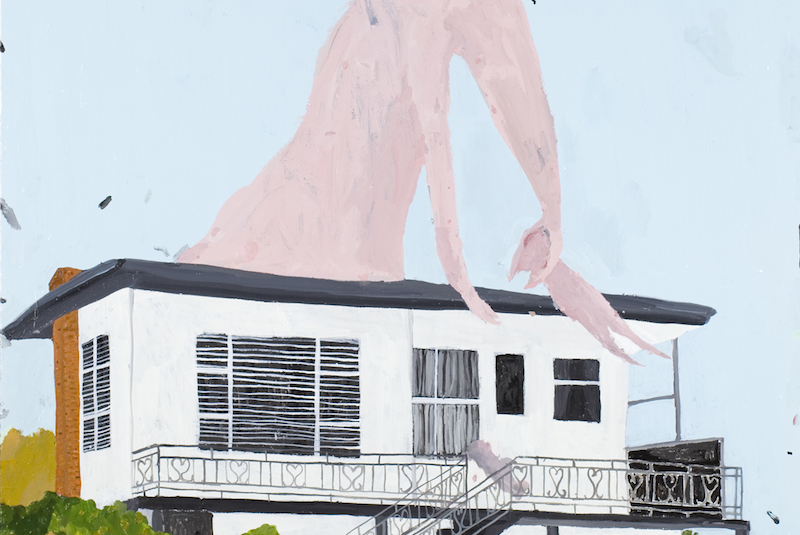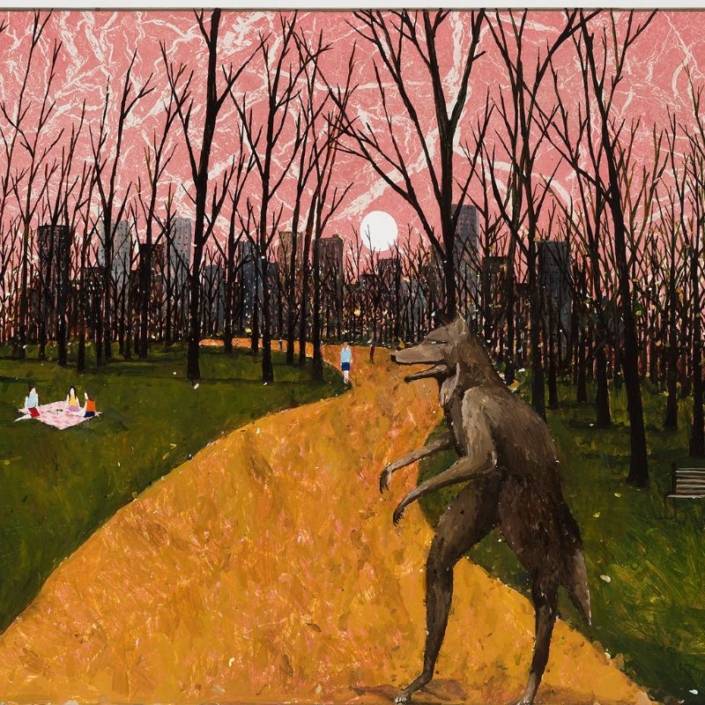Richard Lewer: Boxing with the Biblical
Richard Lewer’s work ruminates upon monumental themes. He tells Art Collector he is drawn to extremes with his regular themes of sport, crime and religion.
Words: Phip Murray
For his exhibition at Hugo Michell Gallery later this year, Richard Lewer is exploring the Ten Commandments. A more difficult and epic subject matter is hard to imagine: “I had always wanted to tackle the Ten Commandments,” states Lewer. “The question of how to deal with these biblical statements – these monumental statements – has long interested me but I never felt I was ready.”
When he relocated to Perth in 2012, a visit to Fremantle provided the final (might we say divine) inspiration. “I took a tourist bus and one of the locations was the Fremantle Prison, probably the town’s biggest tourist attraction. I have always been drawn to criminals, and have worked with crime a lot in my work, so the building already fascinated me. One of the most interesting things was the Prison Chapel where the Ten Commandments are painted on the wall. It is the only room in the prison that does not have bars and which lets in light. You could imagine the prisoners being drawn to the room because of those characteristics while also being made to read the Ten Commandments on an almost daily basis,” he comments. Religious themes have long preoccupied Lewer who was “brought up strict Catholic” in the country town of Hamilton, New Zealand. “In a way, I continue to look at faith and religion to work out my own beliefs. I was an altar boy, I was enrolled into the fraternity but, now, I feel I am on the outside looking in. I have always been fascinated by priests, for example. I am fascinated by their discipline and faith, their solemn lifestyle, their belief in something. As a kid, my mother would take dinners over to the priest’s house and I was captivated – you know, what does he do? How does he exist? So much of what we read about priests in the papers is negative now but I didn’t have that experience. It’s about something else for me, and I am trying to work it out.”
Lewer’s work customarily ruminates upon monumental themes: “I guess I am drawn to the extreme, whether it’s crime, sport or religion. That seems a good way to sum it up.” These big themes are, however, abstracted in both form and content to make them interestingly idiosyncratic and poetically resonant. A compelling aspect of Lewer’s work is the tension between the literal and the poetic. He is in part a social realist, faithfully documenting suburban life, yet his paintings also evoke other, more ethereal and lyrical ideas. “I hover between figuration and abstraction because I don’t necessarily want full control,” he states. “I know what I want from the painting but I let the accidents happen. I let people view it in a free context rather than tightening it up to make it concrete. Increasingly, I am exploring the idea of pushing the paint towards a more abstracted form – almost letting it become more like a memory.”
The everyday is blended with the supernatural in Lewer’s Ten Commandments paintings to compelling effect. In one painting, for instance, a ubiquitous suburban house is clambered over by an unearthly and probably malevolent pink figure with a spooky blacked- out face. In Thou shalt not commit adultery, a marital bed has turned otherworldly through the strange spotted shadow cast across it – its twin outline a ghostly apparition of the two bodies that have presumably lain within it but which are now vanished. The first glance of a portrait of an older couple in a lounge room – an image based on the artist’s own parents – seems relatively innocuous but closer inspection reveals the strange sliding qualities within in: the feverishly red carpet tilts uncomfortably, the subjects’ features seem awkwardly flattened, and a crack in the wall appears a harbinger of disquiet. The pull between the figurative and the abstract in his paintings sometimes manifest his images with the weird woozy logic of dreams. “The more I make work, the less control I want,” states Lewer. “That’s why I try to use as many different materials as possible because I don’t want to become familiar with any particular material. The need to keep struggling, to not have total control of my materials is hugely important to this process. It’s nuts but, the bigger the struggle, the better it is for me.”
The text-based works that accompany the images increase the feeling of free association operative in the series. Written in clumsy handwriting across hole-filled surfaces, they read as inconclusive but highly poetic statements, which can be interpreted in different ways against different images. “Get out of my dreams” reads one; “You have much to be thankful for” another; and “Nobody can say I haven’t tried.”
Many often comment on Lewer’s intense drive to make art – for this he is fondly regarded as an “artist’s artist”. Most of Lewer’s days are spent in the studio, with the artist stopping in the late afternoon to take up his boxing gloves – Lewer is a committed boxer and, increasingly, a trainer of other boxers. Boxing and art are part of his daily practice. Of art, he states: “I don’t think I had much choice in the matter of being an artist. It’s more like a curse,” he says, not without some humour. “It’s a curse because it burns in you and you have to do it whether you like it or not. I have used art to get well. I paint to get well. I used to hide that idea in a way, but that’s the truth of my work. Something burns within me and I need to tell these stories.”
Hugo Michell
DIRECTOR, HUGO MICHELL GALLERY
Hugo Michell and Richard Lewer have worked together for five years now. Michell first met Lewer at Gertrude Contemporary in Melbourne when he was giving an artist talk in his studio: “I was hooked and hung around after the talk to meet him. I was instantly taken by the diversity of his subject matter but still felt that he was somehow managing to tie it all together and make it concise. He has always been a tough artist who works with darker subject matter, yet there can often be an underlying humour (albeit black).
“Richard is working towards a show for us in December this year based around the subject of the Ten Commandments. This is a subject he has wanted to do his entire career – as he said, ‘you only get one shot at them’ – so we feel very honoured to be exhibiting the body of work.”
This is Lewer’s third solo exhibition this year and Michell anticipates the show to be popular with collectors, the gallery director comments: “Richard has a very solid collector base. He is collected widely and is in serious private collections throughout Australia and New Zealand and, increasingly, further abroad. His work is in high demand and we are rarely left with anything after an exhibition, which means his collector base has to wait for the next body of work. He is also held in many national institutions such as the Art Gallery of South Australia, the National Gallery of Victoria, the Museum of Contemporary Art Australia, Monash University Museum of Art and the Museum of New Zealand Te Papa Tongarewa. In 2012, Gertrude Contemporary invited him to do their annual Gertrude Edition. Richard created 78 unique hand-painted works, each of which represented a tarot card. They all sold out within 24-hours.”
Alexie Glass-Kantor
DIRECTOR / SENIOR CURATOR, GERTRUDE CONTEMPORARY
Alexie Glass-Kantor’s association with Richard Lewer started around 2006 when his work began gaining wider recognition and traction in Australia. In 2008 he was accepted into the Gertrude Contemporary Studio Program and Glass-Kantor has subsequently worked with him as a curator and also written on his work in various contexts.
Glass-Kantor comments: “What initially led my interest in Lewer’s approach was the instinctively methodological and meticulous research that underpins each series produced. He is often working on several ideas at a time and researching parallel and contradictory trajectories. These might include, for instance, the politics of surveillance, the psychological dimensions of suburbia, religious and occult speculations, sports culture or masculinity in a process of crisis or confrontation. There is always an in-depth narrative underpinning his practice, which is fed by a relentless curiosity that propels the work forward and drives the artist to utilise creative development as a means for exploration.
“There is a latent menace that lurks beneath the surface – an undercurrent of the unseen, the unspoken or the darker sides of the self, an inclination towards the taboo – and, yet, there is also a lightness of touch and a generosity in the works. The surfaces are always superlatively seductive. Whether he is creating large-scale wall drawings in charcoal, working in video and animation, or using oil-based paints on metal there is a reverent mastery of materiality. He has a very strong understanding of precedents in painting and he is a very accomplished technician and, because of that background, he can let go of all those rules and extend his methods of production.”
Richard Lewer’s commitment to his practice is admirable according to Glass-Kantor, “Lewer is absolutely relentless in his dedication to the making of art and images. There is persistence in what he does; he makes images regardless of outcomes such as exhibitions or commissions and I think that is going to stand him in great stead over the coming years. His work is becoming increasingly visible for audiences, across both the market and institutional context. I think he is an artist that is really hitting his stride now. It’s going to be remarkable to watch as he becomes progressively more assured in negotiating thresholds between subjectivity, production and audience. He will always make art. He is one of those artists that just always makes art, and it’s exhilarating to be around him.”
This article was originally published in Art Collector issue 66, OCT-DEC 2013.









